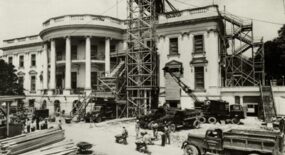White House Stonecutting Tools
Copyright © White House Historical Association. All rights reserved under international copyright conventions. No part of this article may be reproduced or utilized in any form or by any means, electronic or mechanical, including photocopying, recording, or by any information storage and retrieval system, without permission in writing from the publisher. Requests for reprint permissions should be addressed to books@whha.org
Inventories of the tools in the stonecutting sheds suggest that some of the stone was sawed, a technique that bypassed usual tooling used to "finish" the stone's surface. The cut resulted in two stones, each with a smooth face. This had particular advantages in cutting ashlar, for only one face had to be exposed. Another plus was that it could be accomplished by unskilled labor under direction. Even at best it was a long, tedious process. The saw, unserrated, had a sharp copper or iron blade fixed in a heavy wooden frame. One or two men worked the saw, while another poured wet sand into the cut. To speed completion of the house, "composition ornaments" bought in Baltimore, made of plaster of Paris and reinforced with wire, were used as the moldings and the plasterwork decoration on the house's interior - architraves, friezes, cornices, and chimneypieces.

Detail from an 1800 watercolor by William Birch of stone cutters (in the bottom left) at work at the Capitol. Many of the same workmen and craftsmen also had worked on the White House.
































































